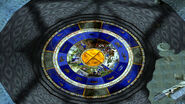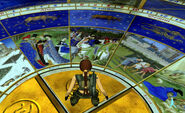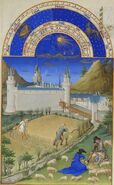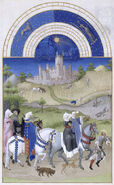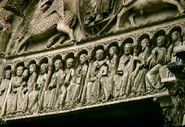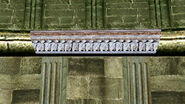(→Trivia) Tag: Visual edit |
(→Trivia) Tag: Visual edit |
||
| Line 212: | Line 212: | ||
<em>The west portal is one of the treasures of Romanesque sculpture, presenting the story of the Apocalypse according to St. John, and the Gospel of St. Matthew. Christ is seated in majesty in the timpanum, with the symbols of the Evangelists around him; the angel of St. Matthew, the lion of St. Mark, the bull of St. Luke, and the eagle of St. John. The Apostles are seated below him. (from [https://en.wikipedia.org/wiki/Church_of_St._Trophime,_Arles '''wikipedia''']) </em> |
<em>The west portal is one of the treasures of Romanesque sculpture, presenting the story of the Apocalypse according to St. John, and the Gospel of St. Matthew. Christ is seated in majesty in the timpanum, with the symbols of the Evangelists around him; the angel of St. Matthew, the lion of St. Mark, the bull of St. Luke, and the eagle of St. John. The Apostles are seated below him. (from [https://en.wikipedia.org/wiki/Church_of_St._Trophime,_Arles '''wikipedia''']) </em> |
||
| + | |||
| + | '''13.14 - Relief''' |
||
| + | |||
| + | Some relief with a knight on it. The scenery came from the interior of the '''[https://en.wikipedia.org/wiki/Reims_Cathedral Reims Cathedral]'''. Detail of the back of the facade showing the “communion of the knight”, cathedral of Reims. |
||
| + | |||
| + | '''13.15 - Strange door''' |
||
| + | |||
| + | The door with skeletons on it. It is just weird |
||
| + | |||
| + | <u>coming soon</u> |
||
| + | |||
| + | '''13.16 - Latin text''' |
||
| + | |||
| + | <u>Coming soon</u> |
||
| + | |||
| + | '''13.17 - Effegie''' |
||
| + | |||
| + | I think the sculpture with Brother obscura on top is based on the sculpture of '''[https://en.wikipedia.org/wiki/Philippe_Pot Phillipe Pot]''', now in the Louvre. |
||
| + | |||
| + | '''13.18 - Skeletons on the walls''' |
||
| + | |||
| + | The skeleton art in the room with Brother Obscura comes from the '''[https://en.wikipedia.org/wiki/Catacombs_of_Paris Ossuaries in Paris]''' and other countries. Maybe the texture came from Faro, Portugal or Chapel of Martyrs in Otranto. |
||
== Trivia == |
== Trivia == |
||
Revision as of 21:01, 17 July 2020
The Hall of Seasons is a level from Tomb Raider Angel of Darkness.
About this level
The hall of seasons is one giant big level. It is part of the Tomb of ancients, and contains sub levels that apparently have elements of the seasons. Hence the name, I guess.
- The breath of Hades: element wind
- Neptune's Hall: element water
- Sanctuary of the Flame: element fire
- Wrath of the beast: element earth
If Lara complete this levels, she will get amulets. She places these amulets in their holders and it opens a room with a machine in it. To operate this machine she will combine these elements. The machine activate some movable objects and Lara will continue to the upper levels of this level.
At the top of the level Lara will obtain an obscura painting from a ghost. This ghost is Brother Obscura who will defend his painting for being stolen. At the end of the level Lara will continue in the Tomb of ancients level and get back to the archaeological dig.
Picture by picture
13.01 - The big circle
The first thing that comes in mind is the big circle. Which consist of the months of the year and some astrological signs. The illustrations came from a medieval scripture called Très Riches Heures du Duc de Berry.
It was created between c. 1412 and 1416 for the extravagant royal bibliophile and patron John, Duke of Berry, by the Limbourg brothers.[2] When the three painters and their sponsor died in 1416, possibly victims of plague, the manuscript was left unfinished. It was further embellished in the 1440s by an anonymous painter, who many art historians believe was Barthélemy d'Eyck. In 1485–1489, it was brought to its present state by the painter Jean Colombe on behalf of the Duke of Savoy. Acquired by the Duc d'Aumale in 1856, the book is now MS 65 in the Musée Condé, Chantilly, France. (from wikipedia)
13.02 - The Water Sign
If Lara steps on the water sign she looks at Januarius (January), Februarius (February) and Martius (March).
| Month | Astrological sign | Picture description |
|---|---|---|
| January | Capricornus | Page from the calendar of the Très Riches Heures showing the household of John, Duke of Berry exchanging New Year gifts. The Duke is seated at the right, in blue. |
| February | Aquarius | An enclosure surrounds a farm comprising a sheep pen and, on the right, four beehives and a dovecote. Inside the house, a woman and a couple of young man and young woman warm themselves in front of the fire. Outside, a man chops down a tree with an axe, bundles of sticks at his feet, while another gets ready to go inside while blowing on his hands to warm them. Further away, a third drives a donkey, loaded with wood, towards the neighbouring village. (From here) |
| March | Pisces | In the foreground, a peasant ploughs a field with a plough pulled by two oxen, the man steering them with a long goatee. Winegrowers prune the vine in an enclosure on the left and plough the soil with a hoe to aerate the soil: these are the first ways of the vine. On the right, a man leans over a sack, probably to draw some seeds that he will then sow. Finally, in the background, a shepherd takes the dog that guards his flock. In the background is the castle of Lusignan (Poitou), property of the Duke of Berry who had it modernized. On the right of the picture, above the Poitou tower, a winged dragon representing the fairy Mélusine. (From here) |
13.03 - The Earth Sign
If Lara steps on the earth sign she looks at Aprillis (April), Maius (May) and Junius (June).
| Month | Astrological sign | Picture description |
|---|---|---|
| April | Aries | The main subject of this painting is an engagement scene: in the foreground, on the left, a couple exchanges rings in front of two witnesses and another character, represented behind, smaller than the others. More in the center, two following pick flowers. On the right, you can see an orchard enclosed by walls and a crenellated building. In the background stands a castle, often referred to as Dourdan Castle. It could also be the Château de Pierrefonds. (Translated from French: here) |
| May | Taurus | This month is illustrated by the traditional cavalcade of May 1: young people go on horseback, preceded by trumpet players. They go into the forest to look for twigs that they will carry on their heads or around their necks. On this occasion, the ladies sport a long green dress, as is the case here with three of them. Several figures wear leaves in their hairstyles. The constructions in the background have given rise to differing interpretations. It could be the Palais de la Cité in Paris with the Châtelet on the left, the Conciergerie and the Clock Tower. (Translated from French: here) |
| June | Gemini | It is an illustration of peasant work with a haymaking scene. While in the foreground a woman rakes hay and another puts it in a haystack using a fork, three mowers form swaths in the background on the right. Other tiny figures are depicted in a boat on the river, on the staircase leading to the postern and on the covered staircase inside the palace. The scene takes place on the banks of the Seine, in a field located at the site of the Hôtel de Nesle, the Parisian residence of the Duke of Berry. On the other side of the river stretches the length of the Palais de la Cité, successively with the King's gardens, the Salle sur l'eau, the three Bonbec, Argent and César towers, then the 'Clock. Behind the Saint-Louis gallery in the center, the two gables of the Great Hall, the King's Logis and the Montgomery tower. On the right, the Sainte-Chapelle. (Translated from French: here) |
13.04 - The Fire Sign
If Lara steps on the fire sign she looks at Julius (July), Augustus (August) and September.
| Month | Astrological sign | Picture description |
|---|---|---|
| July | Cancer | The work in July represents the harvesting and shearing of sheep. Two figures mow the wheat using a steering wheel and a stick. A steering wheel is a long, open sickle whose handle is at an angle to the flat of the blade. Using the stick, they release a bundle of rods which they cut by launching the steering wheel. The harvesters advance from the outside of the plot, turning towards its center by turning. One of them wears a whetstone on his belt. Two other figures, including a woman, cut the wool from sheep with the help of force. With the exception of imaginary mountains, the landscape represents, in the foreground, the Boivre river flowing into the Clain, near the Comtal Palace of Poitiers. (From here) |
| August | Leo | In the foreground, there is a scene of falconry: the procession on horseback goes hunting, preceded by a falconer. He holds in his right hand the long stick which will allow him to beat trees and bushes to make the game fly away. He wears two birds in his fist and, on his belt, a bird-shaped lure that was garnished with meat to encourage the hawks to return. The procession is accompanied by dogs intended to raise the game or to bring back the one which will have been slaughtered. On their horse, three figures carry a bird, probably a hawk or a merlin. In the background are represented the agricultural work of August. A peasant mows the field, a second gathers the ears in sheaves while a third loads them onto a cart pulled by two horses. Nearby, other figures are bathing in a river - perhaps the Juine - or drying in the sun. In the background stands the Château d'Étampes, which the Duke of Berry had acquired in 1400 upon the death of Louis d'Évreux, Count of Étampes. Behind the ramparts, we can see the quadrangular keep and the Guinette tower, which still exists. (From here) |
| September | Virgo | September is illustrated by the harvest. Five figures pick grapes while a man and a woman, apparently pregnant, rest. The bunches are placed in baskets which are then emptied into hoods fixed on mules. These hoods are themselves poured into tanks loaded into carts drawn by oxen. The second plan is entirely occupied by the castle of Saumur in Anjou, a wine-growing region at the time. The towers are topped with lilies weathervanes. Around it, a line is represented with its central bar and its trellis wall. (From here) |
13.05 - The Wind sign
If Lara steps on the wind sign she looks at October, November and December.
| Month | Astrological sign | Picture description |
|---|---|---|
| October | Libra | The peasant scene in the foreground represents the sowing. On the right, a man sows on the fly. Magpies and crows peck the seeds that have just been sown, near a white bag and a game bag. Behind, a scarecrow in the shape of an archer and taut threads, on which feathers are hung, are intended to keep the birds away. On the left, a peasant on horseback passes the harrow on which a stone is placed which allows the teeth to penetrate deeper into the ground. It thus covers the grains which have just been sown. In the background, the painter represented the Louvre Palace. From the castle in the center, we can distinguish, in addition to the central keep which then housed the royal treasury, the eastern facade on the right, framed by the Taillerie tower and the Chapel tower, and on the left the southern facade, with its two towers twinned in the center. The whole is surrounded by an enclosure punctuated by three towers and two breteches, visible here. On the shore, characters converse or walk. (from here) |
| November | Scorpius | The miniature represents a traditional peasant scene in autumn: the glandée. A pigsty, accompanied by a mastiff, grazes a herd of pigs in an oak wood. Using a stick that he throws, he hits the branches to make the acorns fall. The pig, fattened then killed and salted, will prepare for winter and feed all year round. We can see in the background a castle hanging on the rocks and a river which winds between the blued mountains. (From here) |
| December | Sagitarius | For the last month of the year, the painter did not use the traditional iconography of the pig slaughter for Christmas to prefer a scene of venison. It is more precisely about the priest, at the moment when one of the hunters, on the right, finishes ringing the hallali. Dogs butcher the boar. The scene takes place in the center of a forest whose trees are still in leaf. On the horizon stands the castle of Vincennes, completed by Charles V, with its central keep and its towers. (From here) |
13.06 - Green man #1
The green man looks a bit like the second one. This came from this website. It is called the Wye Valley Green Man.
13.07 - Green man #2
This green man came from this website and it is called: Halford Green Man.
13.08 - Green man #3
This green man came from this website. Called Blackman Green Man.
13.09 - Green man #4
Coming soon.
13.10 - Apostles.
A frieze of apostles in the Royal Portal from the Chartres Cathedral in France.
Fourteen figures occupy the lintel, identified as the twelve apostles, to whom Christ said at the Last Supper, “You shall sit on thrones as judges of the twelve tribes of Israel” (Luke 22:30) and Enoch and Elijah at either end. (Website)
13.11 - Christ figure
The Christ figure can be found at the Chartres Cathedral and it is a real gem that the members of Core Design put this in the game.
The central portal and tympanum with Christ in Majesty in a mandorla surrounded by the four apocalyptic beasts (Website)
13.12 - Frieze.
The skeleton pops out of its cage when Lara runs near it. It has a frieze of walking men on it. These came from the Church of Saint Tromphime in Arles. It is near the portal of the Romanesque church.
13.13 - Jesus and pals
The Christ figure can be found at the Church of St. Trophime in Arles.
The west portal is one of the treasures of Romanesque sculpture, presenting the story of the Apocalypse according to St. John, and the Gospel of St. Matthew. Christ is seated in majesty in the timpanum, with the symbols of the Evangelists around him; the angel of St. Matthew, the lion of St. Mark, the bull of St. Luke, and the eagle of St. John. The Apostles are seated below him. (from wikipedia)
13.14 - Relief
Some relief with a knight on it. The scenery came from the interior of the Reims Cathedral. Detail of the back of the facade showing the “communion of the knight”, cathedral of Reims.
13.15 - Strange door
The door with skeletons on it. It is just weird
coming soon
13.16 - Latin text
Coming soon
13.17 - Effegie
I think the sculpture with Brother obscura on top is based on the sculpture of Phillipe Pot, now in the Louvre.
13.18 - Skeletons on the walls
The skeleton art in the room with Brother Obscura comes from the Ossuaries in Paris and other countries. Maybe the texture came from Faro, Portugal or Chapel of Martyrs in Otranto.
Trivia
sdf== Navigation ==
